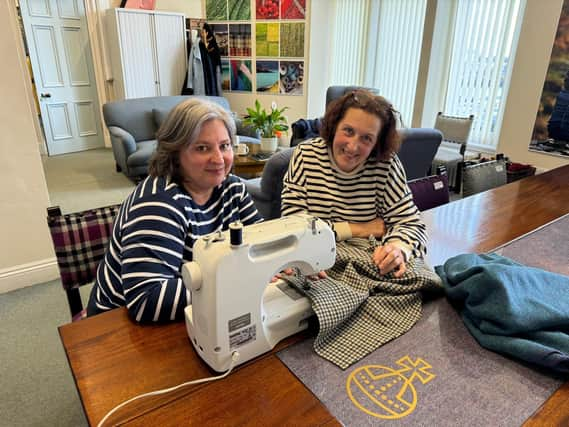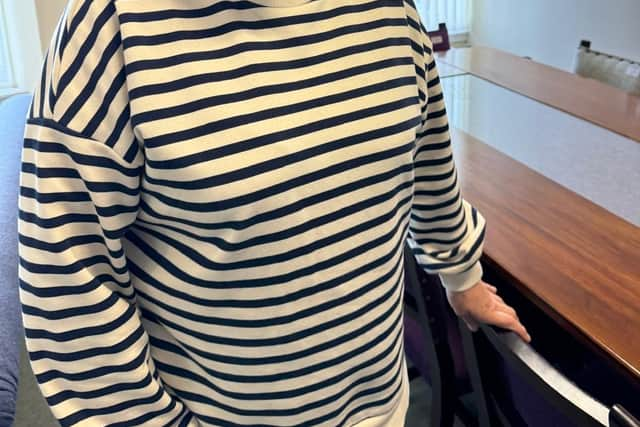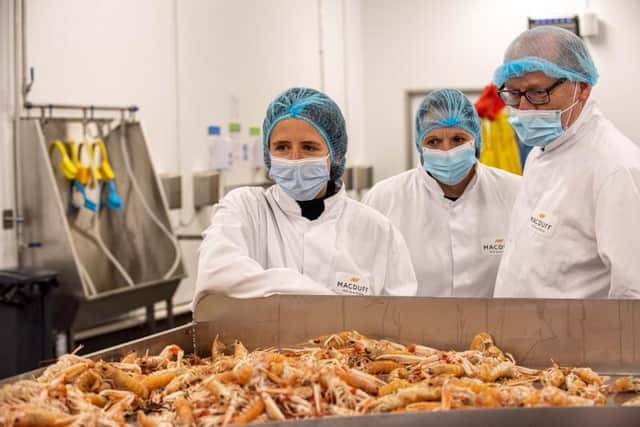How Latvian influx has built a tailor made legacy


Stornoway’s history reflects all of that and one current example is Dzintra Reinfelde, Latvian by birth and now firmly established as a tailor and seamstress of distinction. She has filled a gap in the local market, with a particular emphasis on Harris Tweed.
According to Dzintra, there are about 60 immigrants from Latvia in Lewis; some of them Russian by ethnicity. In Soviet days, Latvia was more closely tied to its giant neighbour than the other Baltic republics. About a third of Latvia’s 1.9 million population are of Russian origin.
Advertisement
Hide AdAdvertisement
Hide AdThis Latvian in-migration to Lewis resulted from the Young’s seafood factory on Goat Island needing workers in the first decade of the century. In 2004, there was a major expansion of the European Union and Latvia was one of the accession states. This led to free movement of labour with fast access in sectors like fish processing and hospitality.


Young’s had a history of bringing in workers from eastern Europe, mainly from Ukraine which was outside the EU. John Nicolson, who ran Young’s recalls: “After a while, the Home Office started putting pressure on us to stop taking Ukrainians and start employing people from inside the EU and that was why we started bringing in Latvians.
“There was an agent in Aberdeen and I agreed to work with her on condition that we paid the people directly so that they got everything they earned. She agreed to that and from there we never looked back. They were the best workers we ever had and nice people as well. I still see some of them around the town.
“We loved them, looked after them, housed them and it was all just a thank you for what they were doing for us”. Among these early Latvian arrivals was Dzintra’s teenage daughter, Baiba.
Advertisement
Hide AdAdvertisement
Hide AdDzintra recalls: “My elder daughter came here first with friends when she was 16, to work at Young’s. There were agencies looking for east European workers. After six months, she came back to Latvia to finish school but then she wanted to return to Stornoway. I was surprised. It was not an easy job and she had been working night-shifts. But she wanted to go back”.


This left Dzintra with two younger children in Riga and eventually she decided that the best course of action was for them all to join Baiba in Stornoway. She arrived with very little English and initially the accommodation for the four of them was in a house with other Young’s workers in the centre of Stornoway.
“When I came here”, she says, “it was very hard to get jobs”. She cleaned houses and washed dishes in a local hotel. But it took time for the fact to emerge that Dzintra was a highly skilled tailor who was perfectly capable of working at her profession if the opportunity existed. And tailoring was one skill which the island certainly required.
Dzintra grew up in Riga when Latvia was part of the Soviet Union. “Latvia was a very rich country”, she recalls. “There were huge factories. Latvia built trains for the whole of the Soviet bloc. We made radios for the whole country … It was good”. And, whatever its other deficiencies, the Soviet system provided high quality technical education.
Advertisement
Hide AdAdvertisement
Hide Ad“There were many of these institutions teaching professional skills”, she says. “My grandmother had been very good at sewing and I always had an interest. I studied tailoring for three years and did another six month course in finishing. Russian designers and specialists came to teach us. It was a very high quality of training”.
In the late 1980s, the Soviet Union started to break up and Latvia became independent in 1991. “All these factories closed”, says Dzintra. These were difficult economic times as the old certainties of employment within a planned economy disappeared and social provision became very limited. For Dzintra, it was a tough period in which to raise a family and earn a living.
For several years, she had her own workshop in Riga but that failed “because people had no money”. Latvia’s ambition was to join the EU and that was finally achieved in 2004. While membership was positive in some ways for the Latvian economy, it also led to a mass emigration to more prosperous EU countries. Dzintra and her family became part of that movement. “I was not coming here from a good life”, she says.
When she arrived in Lewis, Dzintra’s possessions did not include any of the equipment required for her profession. A lady who worked for Young’s gave her a domestic sewing machine and her first break came through one of her cleaning jobs. “I made a Harris Tweed coat for this man”, she recalls, “and he became my walking advert”.
Advertisement
Hide AdAdvertisement
Hide AdThe man in question was Alasdair Morrison, the former MSP who was at that time living in Point. Alasdair says: “Having got to know the family, she offered to make the coat. That was the start. People would ask – where did you get that coat? I would give her Dzintra’s contact details and that kicked things off”.
By this time, Dzintra and her family were living in an HHP house in Stornoway’s Queensland Road and a room within it became her studio. The work began to trickle in and most of it involved Harris Tweed – either requests to make garments for both men and women, or to alter them.
“My English at that point was zero”, says Dzintra. “But I was working with people so I needed the language to be able to talk to them. I like chatting. I like talking to people”, she says in excellent English which results largely from a course at Lews Castle College where, she says, “there was very good teaching”.
Lorna Macaulay, chief executive of the Harris Tweed Authority, became both a customer and a friend. It was clear that Dzintra was filling a gap in the market and that the HTA could help by providing a loan which allowed her to buy an industrial sewing machine. Dzintra says: “I was very reluctant. I have always done things for myself but I finally took this help”.
Advertisement
Hide AdAdvertisement
Hide AdThe machine greatly increased the range of work she could take on and the loan was re-paid on schedule. Lorna says: “I strongly sensed that there were lots of people with bolts of tweed waiting in their houses to get something made”. And so it has proved.
Another factor, says Lorna, was the opening of the Harris Tweed Hebrides shop in Stornoway. “There was nowhere before that where people could go and see the wonderful range of colours and patterns, then choose a tweed to have something made from. That created a lot of references from the shop to Dzintra”.
That leads on to the obvious question of whether the operation could become bigger. While Dzintra has remained a one-woman business, she is a firm believer that there is a good market on the island for a Harris Tweed tailoring enterprise. “Since the day we met”, she reminds Lorna, “I have said the island needs a jacket factory”.
That suggestion, as Gazette readers will recognise, has a certain topicality since we recently marked the 50th anniversary of the last attempt collapsing. The way in which the “Samuel Macdonald” factory in Parkend met its end, despite heavy backing from the Highlands and Islands Development Board, left the concept with a bad name and nobody has tried it since.
Advertisement
Hide AdAdvertisement
Hide AdUnderstandably, Dzintra sees it from a very different perspective of time and circumstances. “You have Harris Tweed”, she says, “so why would you not make the coats and jackets?”. Put that way, it seems a very reasonable question.
With tourism booming, cruise ships depositing droves of well-heeled but short-term visitors and an expanding local demand, she knows that a market exists for quick turnaround tailoring which one person, however skilled, cannot meet.
She thinks a factory with five machines would be about right. But then, of course, the sewing skills would also be required. Dzintra is also doing her bit in that direction by teaching night classes at Aros an Rubha. So is there anyone out there to take up the challenge…?
Meanwhile, Dzintra has made progress in changing her existing customers’ behaviour. “When I started”, she says, “people came to me with an old jacket or coat and they wanted exactly the same. Now they are more open to better designs and brighter colours”.
Advertisement
Hide AdAdvertisement
Hide AdAcquiring a command of the English language helps her to inform these decisions. Lorna describes her as “brutally honest about what you should wear” while Dzintra herself says: “I am a very forthright person. Sometimes I say to people – how can you wear this? It’s better to tell them. People are open to all things”.
While Harris Tweed provides a large part of her work, she is by no means restricted to it. For example, she recalls that “last summer was very good for weddings”. Whatever the customer requires, the same exacting standards – and straight talking advice – will be applied!
Dzintra will always be grateful for the help she has received along the way. For her family too, it has been a success story. Baiba is project manager for Aros an Rubha; Anete is now married to a Nicolson in Point; Ricarde, who came when he was five, is in his final year at the Nicolson Institute.
At Goat Island, the employment pendulum has swung back to Ukraine with 15 workers from that beleaguered country currently employed by Macduff Shellfish – successors to Young’s and now running a highly successful operation which markets Hebridean produce to the world.
Advertisement
Hide AdAdvertisement
Hide AdBut without migrant labour, would there still be a factory at Goat Island at all? John Nicolson says: “At the time we took the Latvians on, we couldn’t get local people. I can honestly say without them, we would have had to shut down and the factory would not have been going to the present day”.
These darn migrants!